-
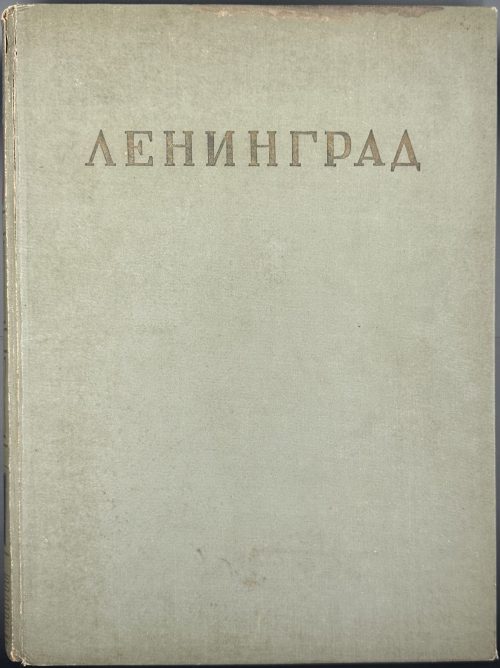 Hardcover volume 36 x 27.5 cm, bound in grey cloth, gilt lettering ЛЕНИНГРАД to front board, red and black labels with gilt lettering, gilt compartments to flat spine, red endpapers with black and white border, pp.: [1-6] 7-402 [2], total 202 leaves with numerous b/w illustrations, plus frontispiece with pasted in b/w plate. Bookplate of Feodor Rojankovsky to front pastedown, ms inscription: “Дорогой Федя, дарю Вам на Ваше рождение эту книгу” signed “Ф. Рожанковский” Half-title (red on tan): ИЗДАНО В ЛЕНИНГРАДЕ | В ДНИ ВЕЛИКОЙ | ОТЕЧЕСТВЕННОЙ ВОЙНЫ || Half-title verso (red on tan): ЛЕНИНГРАДСКИЙ ГОРОДСКОЙ СОВЕТ | ДЕПУТАТОВ ТРУДЯЩИХСЯ | ИСПОЛНИТЕЛЬНЫЙ КОМИТЕТ | {vignette «plan»} | АРХИТЕКТУРНО-ПЛАНИРОВОЧНОЕ | УПРАВЛЕНИЕ | 1943 || Title-page (red on tan) ЛЕНИНГРАД | {vignette «Admiralty»} | ГОСУДАРСТВЕННОЕ ИЗДАТЕЛЬСТВО | «ИСКУССТВО» | ЛЕНИНГРАД – 1943 – МОСКВА || Blue ink stamp to bottom right: Printed in Soviet Union. Title-page verso: РЕДАКЦИОННАЯ | КОЛЛЕГИЯ | Ответственный редактор | БАРАНОВ Н. В. | КАМЕНСКИЙ В. А. | МОРОЗОВ М. В. | РУБАНЕНКО Б. Р. | ФОМИН И. И. | Художник издания | КАМЕНСКИЙ В. А. | Технический редактор | АНИСИМОВ М. Н. Contents (red on tan): АРХИТЕКТУРНО-ПЛАНИРОВОЧНЫЙ | ОБЗОР РАЗВИТИЯ ГОРОДА | РАЗВИТИЕ ГОРОДА В XVIII ВЕКЕ | С. М. ЗЕМЦОВ | РАЗВИТИЕ ГОРОДА В XIX ВЕКЕ | А. Г. ЯЦЕВИЧ | РАЗВИТИЕ ГОРОДА С 1917 ПО 1935 г. | Б. Р. РУБАНЕНКО | ГЕНЕРАЛЬНЫЙ ПЛАН РАЗВИТИЯ | ЛЕНИНГРАДА | Н. В. БАРАНОВ | ИЛЛЮСТРАЦИИ | ГОРОДА || verso: {vignette} | ГЕНЕРАЛЬНЫЙ ПЛАН ГОРОДА ЛЕНИНГРАДА. || Print run: 2,500 copies. Provenance: Feodor Rojankovsky [Rojan, Фёдор Степанович Рожанковский] (Russian-American, 1891 – 1970). Contributors: Каменский, Валентин Александрович (Russian, 1907 – 1975) Земцов, Станислав [Исай] Маркович (1906 – ?) Яцевич, Андрей Григорьевич (Russian, 1887 – 1942) Рубаненко, Борис Рафаилович (Russian-Jewish, 1910 – 1985) Баранов, Николай Варфоломеевич (Russian, 1909 – 1989) Фомин, Игорь Иванович (Russian, 1904 – 1989)
Hardcover volume 36 x 27.5 cm, bound in grey cloth, gilt lettering ЛЕНИНГРАД to front board, red and black labels with gilt lettering, gilt compartments to flat spine, red endpapers with black and white border, pp.: [1-6] 7-402 [2], total 202 leaves with numerous b/w illustrations, plus frontispiece with pasted in b/w plate. Bookplate of Feodor Rojankovsky to front pastedown, ms inscription: “Дорогой Федя, дарю Вам на Ваше рождение эту книгу” signed “Ф. Рожанковский” Half-title (red on tan): ИЗДАНО В ЛЕНИНГРАДЕ | В ДНИ ВЕЛИКОЙ | ОТЕЧЕСТВЕННОЙ ВОЙНЫ || Half-title verso (red on tan): ЛЕНИНГРАДСКИЙ ГОРОДСКОЙ СОВЕТ | ДЕПУТАТОВ ТРУДЯЩИХСЯ | ИСПОЛНИТЕЛЬНЫЙ КОМИТЕТ | {vignette «plan»} | АРХИТЕКТУРНО-ПЛАНИРОВОЧНОЕ | УПРАВЛЕНИЕ | 1943 || Title-page (red on tan) ЛЕНИНГРАД | {vignette «Admiralty»} | ГОСУДАРСТВЕННОЕ ИЗДАТЕЛЬСТВО | «ИСКУССТВО» | ЛЕНИНГРАД – 1943 – МОСКВА || Blue ink stamp to bottom right: Printed in Soviet Union. Title-page verso: РЕДАКЦИОННАЯ | КОЛЛЕГИЯ | Ответственный редактор | БАРАНОВ Н. В. | КАМЕНСКИЙ В. А. | МОРОЗОВ М. В. | РУБАНЕНКО Б. Р. | ФОМИН И. И. | Художник издания | КАМЕНСКИЙ В. А. | Технический редактор | АНИСИМОВ М. Н. Contents (red on tan): АРХИТЕКТУРНО-ПЛАНИРОВОЧНЫЙ | ОБЗОР РАЗВИТИЯ ГОРОДА | РАЗВИТИЕ ГОРОДА В XVIII ВЕКЕ | С. М. ЗЕМЦОВ | РАЗВИТИЕ ГОРОДА В XIX ВЕКЕ | А. Г. ЯЦЕВИЧ | РАЗВИТИЕ ГОРОДА С 1917 ПО 1935 г. | Б. Р. РУБАНЕНКО | ГЕНЕРАЛЬНЫЙ ПЛАН РАЗВИТИЯ | ЛЕНИНГРАДА | Н. В. БАРАНОВ | ИЛЛЮСТРАЦИИ | ГОРОДА || verso: {vignette} | ГЕНЕРАЛЬНЫЙ ПЛАН ГОРОДА ЛЕНИНГРАДА. || Print run: 2,500 copies. Provenance: Feodor Rojankovsky [Rojan, Фёдор Степанович Рожанковский] (Russian-American, 1891 – 1970). Contributors: Каменский, Валентин Александрович (Russian, 1907 – 1975) Земцов, Станислав [Исай] Маркович (1906 – ?) Яцевич, Андрей Григорьевич (Russian, 1887 – 1942) Рубаненко, Борис Рафаилович (Russian-Jewish, 1910 – 1985) Баранов, Николай Варфоломеевич (Russian, 1909 – 1989) Фомин, Игорь Иванович (Russian, 1904 – 1989) -
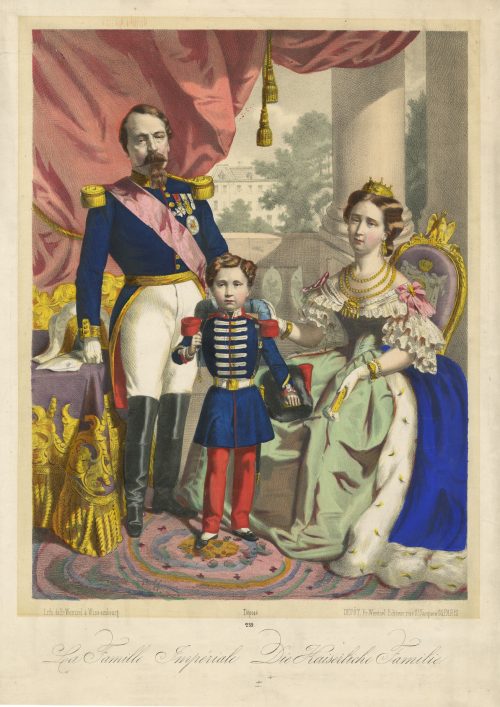 Hand-coloured lithography on wove paper, 395 x 280 mm; black ink stamp “5309” to reverse. On image: artist's initials "L. H."; on stone: "Lith. de Fr. Wentzel a Wissembourg. — Déposé — DÉPÔT, Fr. Wentzel Editeur rue St. Jacques 65, PARIS"; below centre: "239"; bottom : La famille Impériale. Die Kaizerliche Familie. Napoleon III [Charles-Louis Napoléon Bonaparte] (French, 1808 – 1873) Eugénie de Montijo [L'impératrice Eugénie] (Spanish-French, 1826 – 1920) Napoléon, Prince Imperial (Napoléon Eugène Louis Jean Joseph Bonaparte] (French, 1856 – 1879) Jean Frédéric Wentzel (French, 1807 – 1869) – publisher/printer.
Hand-coloured lithography on wove paper, 395 x 280 mm; black ink stamp “5309” to reverse. On image: artist's initials "L. H."; on stone: "Lith. de Fr. Wentzel a Wissembourg. — Déposé — DÉPÔT, Fr. Wentzel Editeur rue St. Jacques 65, PARIS"; below centre: "239"; bottom : La famille Impériale. Die Kaizerliche Familie. Napoleon III [Charles-Louis Napoléon Bonaparte] (French, 1808 – 1873) Eugénie de Montijo [L'impératrice Eugénie] (Spanish-French, 1826 – 1920) Napoléon, Prince Imperial (Napoléon Eugène Louis Jean Joseph Bonaparte] (French, 1856 – 1879) Jean Frédéric Wentzel (French, 1807 – 1869) – publisher/printer. -
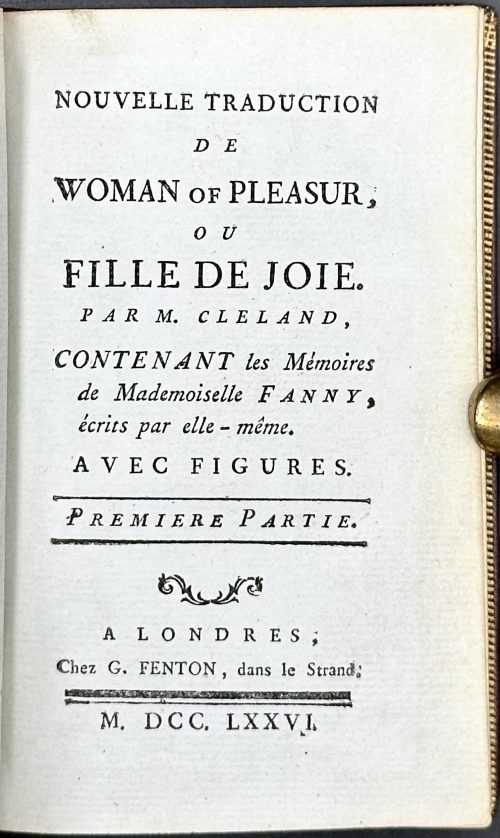 Hardcover volume, collated 18mo, 130 x 85 mm (2 parts in one). Contemporary burgundy morocco outlined with gilt triple fillet, flat spine gilt in compartments, brown morocco label gilt, all edges gilt, gilt dentelle, text printed on slightly blue laid paper with illegible watermark; dark blue endpapers, Tony Fekete (T. F.) bookplate by Wahorn to front pastedown. Frontispiece and 14 engraved plates by Elluin after Borel, with guard tissue. Graphite ms to h.t.: "Figures de Borrel. | Gravées pr. Elluin." Title-page: NOUVELLE TRADUCTION | DE | WOMAN OF PLEASUR, | OU | FILLE DE JOIE. | PAR M. CLELAND, | CONTENANT les Mémoires | de Mademoiselle FANNY, | écrits par elle – même. | AVEC FIGURES | — | PREMIERE (SECONDE) PARTIE. | — | ~ | A LONDRES; | Chez G. FENTON, dans le Strand; | — | M. DCC. LXXVI. || Collation: 18mo throughout A-O12/6, total 126 leaves plus 15 plates, incl. frontispiece. Pagination: separate for each part [1-5] 6-119 [120 blank], [1-3] 4-132, total 252 pages. Provenance: Tony Fekete (Christie’s 2014, № 54, p. 37; Price realized GBP 11,875): “[CLELAND, John (1709-1789).] Nouvelle traduction de Woman of Pleasur [sic] ou Fille de Joie. Contenant les Mémoires de Mademoiselle Fanny, écrits par elle-même. London [but Paris]: G. Fenton [Cazin], 1776. 2 volumes in one, duodecimo (128 x 80 mm). Printed on blue tinted paper. Frontispiece and 14 engraved plates on thick white paper by Elluin after Borel. (Short tear repaired in the margin of one plate, another plate with a faint dampstain touching the facing leaf of text.) Contemporary burgundy morocco, flat spine gilt in compartments, morocco label gilt, covers with a gilt triple fillet border, gilt edges, blue endpapers. THE MOST BEAUTIFUL 18TH-CENTURY ILLUSTRATED EDITION OF THIS CELEBRATED EROTIC NOVEL. An excellent copy bound in contemporary morocco. It is the second translation into French, but the first to include the exquisite plates by Elluin after Borel. These are some of the best illustrations by this remarkable partnership responsible for a number of important 18th-century libertine texts. Cohen-DeRicci 242-3; Dutel A-407 ; Gay-Lemonnyer II, 304; Pia Enfer, 915.” Catalogue raisonné: Dutel (I) A-407, p. 134; Cohen-DeRicci 242-3; Fekete (Christie's) 54, p. 37. Contributors: John Cleland (British, c. 1709 – 1789). François-Rolland Elluin (French, 1745 – c. 1822) Antoine Borel (French, 1743 – 1810) Hubert-Martin Cazin (French, 1724 – 1795) András Wahorn (Hungarian, b. 1953) Fekete, Tony Laszlo (Hungarian, b. 1972)
Hardcover volume, collated 18mo, 130 x 85 mm (2 parts in one). Contemporary burgundy morocco outlined with gilt triple fillet, flat spine gilt in compartments, brown morocco label gilt, all edges gilt, gilt dentelle, text printed on slightly blue laid paper with illegible watermark; dark blue endpapers, Tony Fekete (T. F.) bookplate by Wahorn to front pastedown. Frontispiece and 14 engraved plates by Elluin after Borel, with guard tissue. Graphite ms to h.t.: "Figures de Borrel. | Gravées pr. Elluin." Title-page: NOUVELLE TRADUCTION | DE | WOMAN OF PLEASUR, | OU | FILLE DE JOIE. | PAR M. CLELAND, | CONTENANT les Mémoires | de Mademoiselle FANNY, | écrits par elle – même. | AVEC FIGURES | — | PREMIERE (SECONDE) PARTIE. | — | ~ | A LONDRES; | Chez G. FENTON, dans le Strand; | — | M. DCC. LXXVI. || Collation: 18mo throughout A-O12/6, total 126 leaves plus 15 plates, incl. frontispiece. Pagination: separate for each part [1-5] 6-119 [120 blank], [1-3] 4-132, total 252 pages. Provenance: Tony Fekete (Christie’s 2014, № 54, p. 37; Price realized GBP 11,875): “[CLELAND, John (1709-1789).] Nouvelle traduction de Woman of Pleasur [sic] ou Fille de Joie. Contenant les Mémoires de Mademoiselle Fanny, écrits par elle-même. London [but Paris]: G. Fenton [Cazin], 1776. 2 volumes in one, duodecimo (128 x 80 mm). Printed on blue tinted paper. Frontispiece and 14 engraved plates on thick white paper by Elluin after Borel. (Short tear repaired in the margin of one plate, another plate with a faint dampstain touching the facing leaf of text.) Contemporary burgundy morocco, flat spine gilt in compartments, morocco label gilt, covers with a gilt triple fillet border, gilt edges, blue endpapers. THE MOST BEAUTIFUL 18TH-CENTURY ILLUSTRATED EDITION OF THIS CELEBRATED EROTIC NOVEL. An excellent copy bound in contemporary morocco. It is the second translation into French, but the first to include the exquisite plates by Elluin after Borel. These are some of the best illustrations by this remarkable partnership responsible for a number of important 18th-century libertine texts. Cohen-DeRicci 242-3; Dutel A-407 ; Gay-Lemonnyer II, 304; Pia Enfer, 915.” Catalogue raisonné: Dutel (I) A-407, p. 134; Cohen-DeRicci 242-3; Fekete (Christie's) 54, p. 37. Contributors: John Cleland (British, c. 1709 – 1789). François-Rolland Elluin (French, 1745 – c. 1822) Antoine Borel (French, 1743 – 1810) Hubert-Martin Cazin (French, 1724 – 1795) András Wahorn (Hungarian, b. 1953) Fekete, Tony Laszlo (Hungarian, b. 1972) -
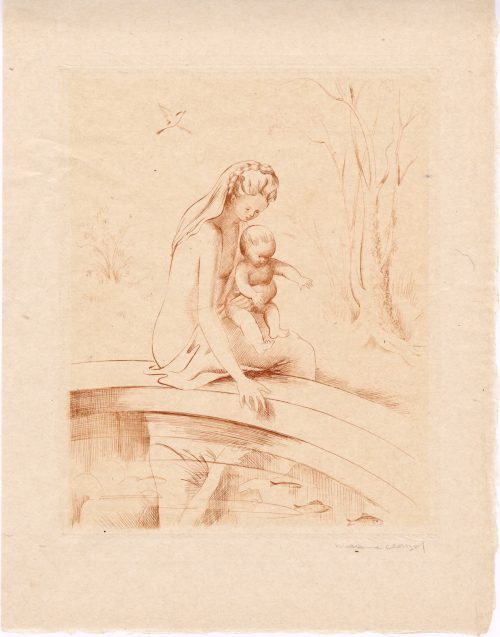 Set of 10 etchings (9 in passe-partout) printed in sanguine on the mother of pearl paper (japon nacre) from the album of 12 prints titled “Jeunesse”, presented by Gérard D'Houville (pen name of Marie de Régnier, née de Heredia) and published by La Tradition in 1945. It was a limited edition of 532 copies, some coloured on Arches paper and some as these set. Plates signed by the artist in pencil below the plate mark. The album cover is missing. Complete data for the album: JEUNESSE | 12 EAUX-FORTES ORIGINALES | DE | MARIANNE CLOUZOT | PRÉSENTÉES | PAR | GÉRARD D'HOUVILLE | {publisher’s device} | LA TRADITION | 1945 || Dimensions: mat 330 x 255 mm; window 225 x 180 mm; sheet 280 x 220 mm; plate 220 x 170 mm. Contributor: Martin van Maële [Martin, Maurice François Alfred] (French, 1863 – 1926)
Set of 10 etchings (9 in passe-partout) printed in sanguine on the mother of pearl paper (japon nacre) from the album of 12 prints titled “Jeunesse”, presented by Gérard D'Houville (pen name of Marie de Régnier, née de Heredia) and published by La Tradition in 1945. It was a limited edition of 532 copies, some coloured on Arches paper and some as these set. Plates signed by the artist in pencil below the plate mark. The album cover is missing. Complete data for the album: JEUNESSE | 12 EAUX-FORTES ORIGINALES | DE | MARIANNE CLOUZOT | PRÉSENTÉES | PAR | GÉRARD D'HOUVILLE | {publisher’s device} | LA TRADITION | 1945 || Dimensions: mat 330 x 255 mm; window 225 x 180 mm; sheet 280 x 220 mm; plate 220 x 170 mm. Contributor: Martin van Maële [Martin, Maurice François Alfred] (French, 1863 – 1926) -
 Iron tsuba of round form with design of two paper lanterns in openwork (small cut-outs, ko-sukashi ) outlined with brass wire. The plate is decorated with four concentric rows of brass dot inlay (ten-zōgan), with a brass circular wire inside the innermost row of dots (missing on the back). Hitsu-ana of rectangular form is not outlined with brass wire, which let us suppose that it was cut out at a later date. Copper sekigane. Mid Muromachi period (1454-1513). Diameter: 74.0 mm, thickness: 2.6 mm. Tsuba is illustrated at: 新版 日本刀講座 小道具鑑定編 本間 薫山 佐藤 寒山 : Shinhan Nihonto Koza, Volume VI, Kodogu Part 1. Under supervision of Honma Kunzan and Sato Kanzan. 鍔 無名 応仁 鉄地) 丸形 小透 槌目 真鍮据文 点象嵌 丸耳 : Tsuba with no signature, Ōnin style. Base metal iron (jigane), round shape, small perforations (ko-sukashi), hammering finish (tsuchime). Pre-cast brass inlay (shinchu suemon-zōgan); dot inlay (ten-zōgan); round edge (maru-mimi).
Iron tsuba of round form with design of two paper lanterns in openwork (small cut-outs, ko-sukashi ) outlined with brass wire. The plate is decorated with four concentric rows of brass dot inlay (ten-zōgan), with a brass circular wire inside the innermost row of dots (missing on the back). Hitsu-ana of rectangular form is not outlined with brass wire, which let us suppose that it was cut out at a later date. Copper sekigane. Mid Muromachi period (1454-1513). Diameter: 74.0 mm, thickness: 2.6 mm. Tsuba is illustrated at: 新版 日本刀講座 小道具鑑定編 本間 薫山 佐藤 寒山 : Shinhan Nihonto Koza, Volume VI, Kodogu Part 1. Under supervision of Honma Kunzan and Sato Kanzan. 鍔 無名 応仁 鉄地) 丸形 小透 槌目 真鍮据文 点象嵌 丸耳 : Tsuba with no signature, Ōnin style. Base metal iron (jigane), round shape, small perforations (ko-sukashi), hammering finish (tsuchime). Pre-cast brass inlay (shinchu suemon-zōgan); dot inlay (ten-zōgan); round edge (maru-mimi).
 English translation of the book indicated above Nihon Tō Kōza, Volume VI, Part 1 by Harry Afu Watson, AFU Research Enterprises, Inc., 1993. Tsuba in question illustrated on page 14 and described as follows: " Tsuba mumei Ōnin. Tetsu ji maru gata ko-sukashi tsuchime shitate shinchū suemon ten zogan maru mimi. Brass suemon". My question remains: why such a text is called 'translation' while it looks more like transliteration of romanization?
English translation of the book indicated above Nihon Tō Kōza, Volume VI, Part 1 by Harry Afu Watson, AFU Research Enterprises, Inc., 1993. Tsuba in question illustrated on page 14 and described as follows: " Tsuba mumei Ōnin. Tetsu ji maru gata ko-sukashi tsuchime shitate shinchū suemon ten zogan maru mimi. Brass suemon". My question remains: why such a text is called 'translation' while it looks more like transliteration of romanization? -
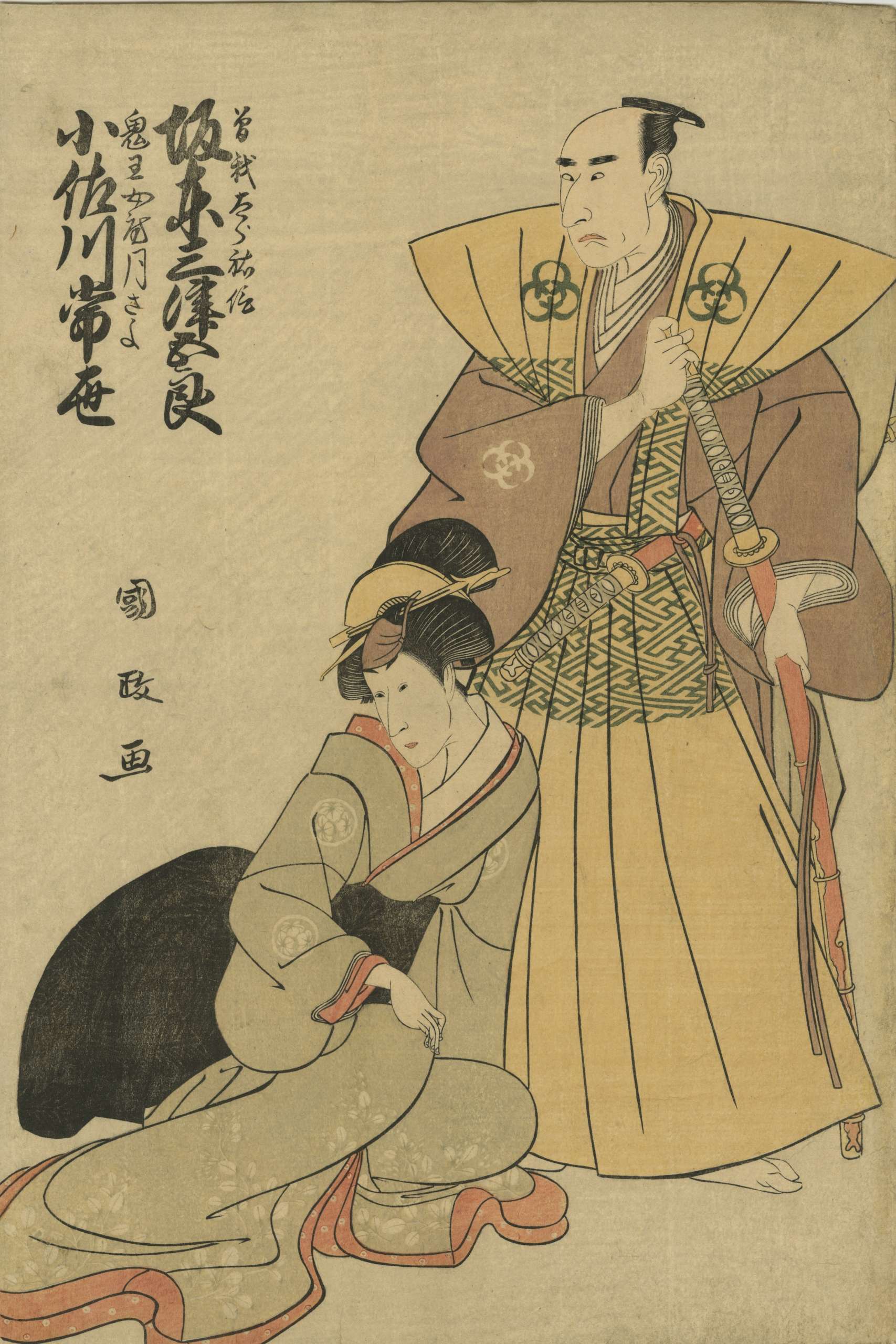 Bando Mitsugoro II as Soga no Taro Sukenobu, the step-father of the Soga brothers, and Osagawa Tsuneyo II as Onio's wife Tsukisayo, in the play 'Omonbi Kuruwa Soga' performed at the Ichimura-za in the 1st month of 1799. Reference: Harvard Art Museums accession number 1933.4.525. Publications: Narazaki Muneshige, Ukiyo-e shuka [Collection of the Masterpieces of Ukiyo-e Prints in Museums] Volume 8: Foggu Bijutsukan [Fogg Art Museum, Harvard University], Neruson Bijutsukan [Nelson Atkins Museum]..., Shogaku-kan (Tokyo, Japan, 1980 [Showa 55]), Color Plate 107; p. 104 (entry p. 191). SOLD
Bando Mitsugoro II as Soga no Taro Sukenobu, the step-father of the Soga brothers, and Osagawa Tsuneyo II as Onio's wife Tsukisayo, in the play 'Omonbi Kuruwa Soga' performed at the Ichimura-za in the 1st month of 1799. Reference: Harvard Art Museums accession number 1933.4.525. Publications: Narazaki Muneshige, Ukiyo-e shuka [Collection of the Masterpieces of Ukiyo-e Prints in Museums] Volume 8: Foggu Bijutsukan [Fogg Art Museum, Harvard University], Neruson Bijutsukan [Nelson Atkins Museum]..., Shogaku-kan (Tokyo, Japan, 1980 [Showa 55]), Color Plate 107; p. 104 (entry p. 191). SOLD -
 Utagawa Toyokuni (歌川豐國); 1769 – 24 February 1825. The actor Nakamura Utaemon as Ishikawa Goemon. Circa 1810. Size/Format: Oban, 9.75 by 14.5 inches
Utagawa Toyokuni (歌川豐國); 1769 – 24 February 1825. The actor Nakamura Utaemon as Ishikawa Goemon. Circa 1810. Size/Format: Oban, 9.75 by 14.5 inches -
 Iron tsuba of round form decorated with chrysanthemums, pine cones and needles, pampas grass, vines, cherry blossoms, and wild geese in brass inlay (suemon-zōgan) and pierced with designs of water clover (denjiso) and half bellflower (or karahana) to the left and to the right of nakago-ana as well as double bars above and below nakago-ana (possibly with the meaning of number 2 or ordinal 2nd). Most probably the sukashi elements here are the family crests (mon). Unsigned. Ōnin school. Muromachi period; 15th or 16th century. Height: 82.1 mm; Width: 80.9 mm; Thickness at seppa-dai: 2.4 mm NBTHK # 2003827: Tokubetsu Hozon Tosogu Kanteisho (特別保存刀装具鑑定書) - "Extraordinarily Worthy of Preservation".
Iron tsuba of round form decorated with chrysanthemums, pine cones and needles, pampas grass, vines, cherry blossoms, and wild geese in brass inlay (suemon-zōgan) and pierced with designs of water clover (denjiso) and half bellflower (or karahana) to the left and to the right of nakago-ana as well as double bars above and below nakago-ana (possibly with the meaning of number 2 or ordinal 2nd). Most probably the sukashi elements here are the family crests (mon). Unsigned. Ōnin school. Muromachi period; 15th or 16th century. Height: 82.1 mm; Width: 80.9 mm; Thickness at seppa-dai: 2.4 mm NBTHK # 2003827: Tokubetsu Hozon Tosogu Kanteisho (特別保存刀装具鑑定書) - "Extraordinarily Worthy of Preservation". -
 Iron tsuba of round form inlaid with brass, copper, and shakudō wire fastened to the surface with metal staples (mukade-zōgan); Scalloped brass inlay around the rim. Early Edo, 17th century. Height: 84.8 mm; Width 84.8 mm; Thickness at seppa-dai: 3.7 mm. Weight 161.6 g. Design is thought to resemble a centipede. "Centipede-like inlay (mukade zogan) of alternating iron and brass staples produce an appearance that was particularly favored by Takeda Shingen (1521-1573), one of the most powerful warlords of his time. The centipede is sacred to Bishamon (God of War) and especially propitious for a warrior. Shingen type, 16th century.” [The Peabody Museum collection of Japanese sword guards with selected pieces of sword furniture, by John D. Hamilton. Photographs by Mark Sexton. Salem, MA, 1975.] See also: http://varshavskycollection.com/shingen-tsuba/
Iron tsuba of round form inlaid with brass, copper, and shakudō wire fastened to the surface with metal staples (mukade-zōgan); Scalloped brass inlay around the rim. Early Edo, 17th century. Height: 84.8 mm; Width 84.8 mm; Thickness at seppa-dai: 3.7 mm. Weight 161.6 g. Design is thought to resemble a centipede. "Centipede-like inlay (mukade zogan) of alternating iron and brass staples produce an appearance that was particularly favored by Takeda Shingen (1521-1573), one of the most powerful warlords of his time. The centipede is sacred to Bishamon (God of War) and especially propitious for a warrior. Shingen type, 16th century.” [The Peabody Museum collection of Japanese sword guards with selected pieces of sword furniture, by John D. Hamilton. Photographs by Mark Sexton. Salem, MA, 1975.] See also: http://varshavskycollection.com/shingen-tsuba/ -
 Artist: Utagawa Toyokuni I (1769–1825) Title: Actors Bando Mitsugorō, Ichikawa Danjūrō, Onoe Kikugorō in play The Maiden at Dōjō Temple. Presumably Bunka 13 (1816) at Nakamura Theater in Edo. Publisher: Mikawaya Seiemon (c. 1805-1829); Marks' "Publishers" № 328, p. 235. Size: Vertical ôban MEDIUM OR TECHNIQUE: Woodblock print (nishiki-e); ink and color on paper. Signed: Toyokuni ga Censor's seal: kiwame Detailed discussion on the topic can be seen at: The Maiden at Dōjō Temple
Artist: Utagawa Toyokuni I (1769–1825) Title: Actors Bando Mitsugorō, Ichikawa Danjūrō, Onoe Kikugorō in play The Maiden at Dōjō Temple. Presumably Bunka 13 (1816) at Nakamura Theater in Edo. Publisher: Mikawaya Seiemon (c. 1805-1829); Marks' "Publishers" № 328, p. 235. Size: Vertical ôban MEDIUM OR TECHNIQUE: Woodblock print (nishiki-e); ink and color on paper. Signed: Toyokuni ga Censor's seal: kiwame Detailed discussion on the topic can be seen at: The Maiden at Dōjō Temple -
 An iron tsuba in the shape of a bold or shaved human head in full round. Unsigned. Dimensions: 62.5 x 53.4 x 4.4 mm Iron, in the shape of a Ni O (Nio) head, in full round, the back flat chased as a pine forest. Signed : Miōchin Masatsugu in sosho. №38 in The Naunton Collection, 1912. There are a few tsuba of such design known. SOLDIron, a severed head. Signed: Takeaki of Kwaiyō. Ex Hawkshaw Collection [Plate VII]. Below written: Takurio, Suruga, 1118; Tamagawa, p. ; Tanaka, p. 168; Tanetora, 1894. №2729 in The Naunton Collection, 1912.
An iron tsuba in the shape of a bold or shaved human head in full round. Unsigned. Dimensions: 62.5 x 53.4 x 4.4 mm Iron, in the shape of a Ni O (Nio) head, in full round, the back flat chased as a pine forest. Signed : Miōchin Masatsugu in sosho. №38 in The Naunton Collection, 1912. There are a few tsuba of such design known. SOLDIron, a severed head. Signed: Takeaki of Kwaiyō. Ex Hawkshaw Collection [Plate VII]. Below written: Takurio, Suruga, 1118; Tamagawa, p. ; Tanaka, p. 168; Tanetora, 1894. №2729 in The Naunton Collection, 1912.
№38 Naunton Collection, 1912.
Reference to Hawkshaw Collection [Plate VII] happened to be not exact; it is Plate VIII, №236. It is clearly not the Hawkshaw piece (different facial expression, signle hitsu-ana, no plug. Description at Hawkshaw, 1910, reads: Iron, in the shape of a man's head, severed at the neck, the forehead in three wrinkles, the mouth hard-set and drooping, the eyes open, inlaid brass with shakudo pupils. Signed: Shoami; dated second year of Shoho, first month [SV: December 1644 through February 1648].
№2729 Naunton Collection, 1912.

№236 Hawkshaw Collection, 1910.
-
 Iron tsuba of round form with three stylized folding fans motif in openwork (sukashi). Kogai-hitsu-ana with shakudō sekigane. Iron bones (tekkotsu) on the rim. Momoyama period or earlier. Possibly, Ko-Shōami school.
Iron tsuba of round form with three stylized folding fans motif in openwork (sukashi). Kogai-hitsu-ana with shakudō sekigane. Iron bones (tekkotsu) on the rim. Momoyama period or earlier. Possibly, Ko-Shōami school.Size: 76.8 x 75.7 x 4.0 mm.
[Seller alleged that the motif is "Buddhist wheel", which seems unlikely. -
 Kikukawa Eizan (菊川 英山, 1787 – July 17, 1867) Signed: Eizan hitsu (英山筆)
Kikukawa Eizan (菊川 英山, 1787 – July 17, 1867) Signed: Eizan hitsu (英山筆)Jacob Pins #972/p.341. Leiden, Rijksmuseum voor Volkenkunde.
"The Lovers Miura-ya Komurasaki and Shirai Gonpachi: Tragic love stories taken from real life and dramatized were a staple of stage and print; the darkly romantic combination of desire and death was hugely popular in the eighteenth century. Hirai Gompachi was a warrior of the Tottori fief in western Japan who fled to Edo after committing a murder. He was apprehended and sentenced to death in 1679. His distraught lover, the courtesan Komurasaki, committed suicide at his grave." [MET]
.
-
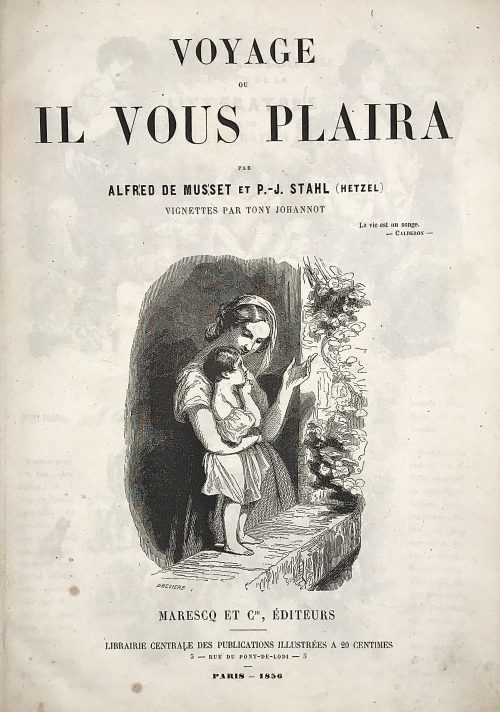
Voyage ou Il vous plaira by Alfred de Musset and P.-J. Stahl (Hetzel); Tony Johannot (illustrations). [Les chefs d'oeuvres de la litterature et de l'illustration] // Marescq et Cie, éditeurs, - Paris, 1856.
Contes de Charles Nodier by Jean Charles Emmanuel Nodier (1780 – 1844) illustrated by H. Émy.
Owner's binding in red half Morocco, A4 (297 x 219 mm). "Voyage ou Il vous plaira" (60 pages) and fairy tales by Charles Nodier with illustrations by H. Émy (Armand-Louis-Henri Telory, born in Strasbourg in 1820 and died in 1874): "La Fée aux miettes" ; "Le songe d'or (fable levantine)"; "La légende de la Soeur Béatrix"; "Trilby"; Inès de las Sierras"; "Baptiste Montauban"; "Smarra ou les démons de la nuit"; "La neuvaine de la Chandeleur"; "La combe de l’homme mort". Extensive foxing, owner's pencil drawings on some pages, otherwise good condition.
-

Large iron tsuba with hammer marks on the surface, small oval opening to the right of nakaga-ana; yamagane fukurin chiselled with tortois shell diaper pattern.
Early Muromachi period (1393-1453). Size: 101.2 x 101.9 x 2.4 (center), 5.2 (rim) mm; weight: 148.4 g. -
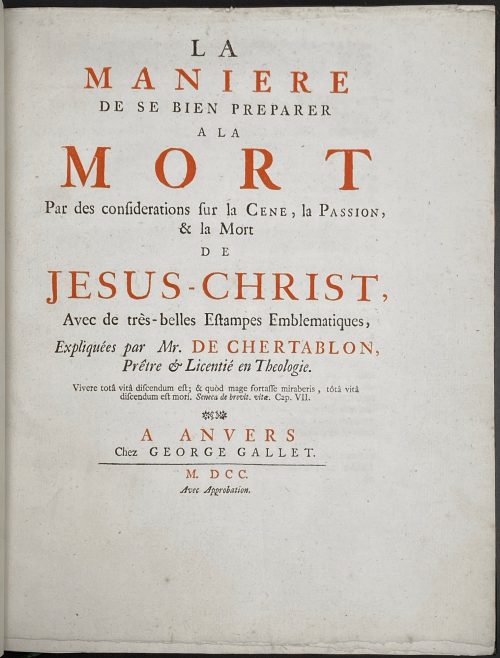 M. de Chertablon. La maniere de se bien preparer a la Mort par des Considerations sur la Cene, la Passion, et la Mort de Jesu-Christ. – Antwerp: George Gallet, 1700. Pagination: ff, [2 - blanks] [2 - t.p., blank] [3 - advert.] 4-63 [64]; 42 copper etched plates by Romeyn de Hooghe: A, B, C, 1-39; [20 - Dutch plate description of the David de la Vigne's Miroir de la bonne mort], bf. Full title: La maniere de se bien preparer a la Mort par des Considerations sur la Cene, la Passion, et la Mort de Jesu-Christ, Avec de très-belles Estampes Emblematiques, Expliquées par Mr. de Chertablon, Piêtre & Licentié en Theologie. Vivere totâ vitâ discendum est; & quòd mage fortasse miraberis, tôtâ vitâ discendum est mori. Seneca de brevit. vitæ. Cap. VII. A Anvers, Chez George Gallet. M DCC, Avec Approbation. / David de La Vigne. Spiegel om wel te sterven, annwyzende met beeltenissen van het lyden onses zaligmaakers Jesu Christi. Verzierd met 42 fyne Geërste Kopere Platen, Door Romain de Hooghe; Te Amsterdam, Voor dezen gedrukt by J. Stigter. Size: 4to, 27.2 x 21.6 cm. Binding: Late 19th century brown calf over marbled boards, spine with gilt lettering, raised bands, double fillet blind panels in compartments; marbled end-papers; bookplate of Samuel Ashton Thompson Yates library, AD 1894. Book illustrated with 42 copperplate etched engravings by Romeyn de Hooghe (Dutch, Amsterdam 1645–1708 Haarlem). According to Bonhams: the plates were "first printed for David de la Vigne's Miroir de la bonne mort. Each of the plates depicts a man contemplating a religious image in order to ease the passing of death, accompanied by commentary and an appropriate verse of scripture for each plate. The present French edition is bound with, as issued, the Dutch translation of David de La Vigne's aforementioned work."
M. de Chertablon. La maniere de se bien preparer a la Mort par des Considerations sur la Cene, la Passion, et la Mort de Jesu-Christ. – Antwerp: George Gallet, 1700. Pagination: ff, [2 - blanks] [2 - t.p., blank] [3 - advert.] 4-63 [64]; 42 copper etched plates by Romeyn de Hooghe: A, B, C, 1-39; [20 - Dutch plate description of the David de la Vigne's Miroir de la bonne mort], bf. Full title: La maniere de se bien preparer a la Mort par des Considerations sur la Cene, la Passion, et la Mort de Jesu-Christ, Avec de très-belles Estampes Emblematiques, Expliquées par Mr. de Chertablon, Piêtre & Licentié en Theologie. Vivere totâ vitâ discendum est; & quòd mage fortasse miraberis, tôtâ vitâ discendum est mori. Seneca de brevit. vitæ. Cap. VII. A Anvers, Chez George Gallet. M DCC, Avec Approbation. / David de La Vigne. Spiegel om wel te sterven, annwyzende met beeltenissen van het lyden onses zaligmaakers Jesu Christi. Verzierd met 42 fyne Geërste Kopere Platen, Door Romain de Hooghe; Te Amsterdam, Voor dezen gedrukt by J. Stigter. Size: 4to, 27.2 x 21.6 cm. Binding: Late 19th century brown calf over marbled boards, spine with gilt lettering, raised bands, double fillet blind panels in compartments; marbled end-papers; bookplate of Samuel Ashton Thompson Yates library, AD 1894. Book illustrated with 42 copperplate etched engravings by Romeyn de Hooghe (Dutch, Amsterdam 1645–1708 Haarlem). According to Bonhams: the plates were "first printed for David de la Vigne's Miroir de la bonne mort. Each of the plates depicts a man contemplating a religious image in order to ease the passing of death, accompanied by commentary and an appropriate verse of scripture for each plate. The present French edition is bound with, as issued, the Dutch translation of David de La Vigne's aforementioned work." -
 Ogata Gekkō [尾形月耕] (Japanese, 1859 – 1920). An uchiwa-e (fan-print) of advertisement of tobacco of Kagoshima Prefecture, c. 1890 (Meiji Period). Barefoot Tengu* is sitting on a torii (entrance to a Shinto shrine), smoking a cigarette through a mouthpiece. _______ * Tengu [天狗] (heavenly dog) is a type of legendary creature found in Japanese folk religion and are also considered a type of Shinto god (kami) or yōkai (supernatural beings).
Ogata Gekkō [尾形月耕] (Japanese, 1859 – 1920). An uchiwa-e (fan-print) of advertisement of tobacco of Kagoshima Prefecture, c. 1890 (Meiji Period). Barefoot Tengu* is sitting on a torii (entrance to a Shinto shrine), smoking a cigarette through a mouthpiece. _______ * Tengu [天狗] (heavenly dog) is a type of legendary creature found in Japanese folk religion and are also considered a type of Shinto god (kami) or yōkai (supernatural beings). -
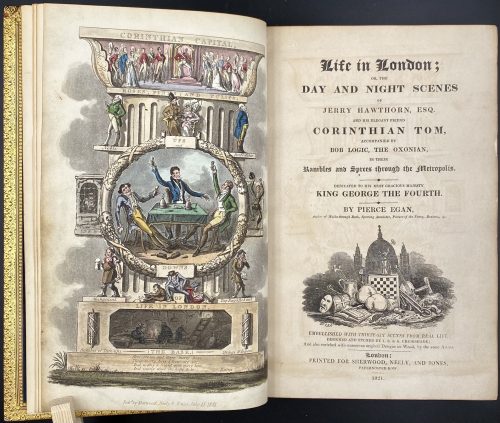
Title: Life in London ; | DAY AND NIGHT SCENES | OF | JERRY HAWTHORN, ESQ. | AND HIS ELEGANT FRIEND | CORINTHIAN TOM, | ACCOMPANIED BY | BOB LOGIC, THE OXONIAN, | IN THEIR |Rambles and Sprees through the Metropolis. | DEDICATED TO HIS MOST GRACIOUS MAJESTY | KING GEORGE THE FOURTH. | BY PIERCE EGAN, | Author of Walks through Bath, Sporting Anecdotes, Picture of the Fancy, Boxiana, &c. | [Vignette] | EMBELLISHED WITH THIRTY-SIX SCENES FROM REAL LIFE, | DESIGNED AND ETCHED BY I. R. & G. CRUIKSHANK ; | And also enriched with numerous original Designs on Wood, by the same Artists, | London: | PRINTED FOR SHERWOOD, NEELY, AND JONES, | PATERNOSTER-ROW. | 1821. ||
Edition: 1st edition, 1st issue: the first sheet of music is not numbered, absence of any footnote at page 9 (as per Cohn).
Pagination: 3 binder's flyleaves with a specimen of George Cruikshank's signature of Nov. 5th, 1860 to the first one; hand-coloured aquatint frontispiece facing the title page with blank recto, [iii-iv] – t.p. with vignette/ blank, [v] vi-viii – dedication, ix-xii – contents, [xiii]-xvi – list of illustrations; [1] 2-376; 35 hand-coloured aquatints, 3 folding leaves of music; bound without half-title [missing pp. i, ii], advertisements or 'to the subscribers' leaf.
Collation: 8vo; [A]7 B-Z8 Aa8-Bb4.
Binding: Full polished calf gilt by Rivière & Son, covers with triple gilt border, spine in 6 compartments, brown morocco lettering pieces to second and third, others richly gilt, raised bands, all edges gilt; neatly re-backed preserving spine.
Catalogue raisonné: Albert M. Cohn, 1924: № 262 p. 90; Abbey, J. R. (Life in England), 281; Tooley (Some English Books with Coloured Plates) 196; Prideaux (Aquatint Engraving) pp. 307, 310; Hardie (English coloured books) 197.
Description of Shapero Rare Books, London: There was a translation into French. At least six plays were based on Egan's characters, contributing to yet more sales. One of these was exported to America, launching the Tom and Jerry craze there. The version created by William Thomas Moncrieff was praised as The Beggar's Opera of its day. Moncrieff's production of Tom and Jerry, or Life in London ran continuously at the Adelphi Theatre for two seasons and it was the dramatist's work as much as the author's that did so much to popularise the book's trademark use of fashionable slang. In 1821 Egan announced the publication of a regular journal: Life in London, appearing monthly at a shilling a time. It was to be illustrated by George Cruikshank (1792 – 1878), and was dedicated to the King, George IV, who at one time had received Egan at court. The first edition of Life in London appeared on 15 July 1821. Egan's creation was an instant success. Pirate versions appeared, featuring such figures as 'Bob Tallyho', 'Dick Wildfire' and the like. Printmakers speedily knocked off cuts featuring the various 'stars' and the real-life public flocked to the 'sporting' addresses that Egan had his heroes frequent.


